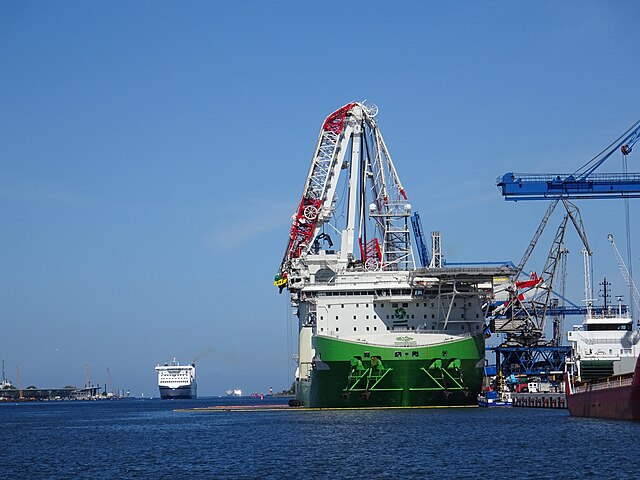The boat is the Orion, and it is BIG, about 710′ long, with a 5,000-ton crane capacity and 8 powerful Thrusters for dynamic positioning. Its coming job is to place and drive the 178 enormous monopiles in Dominion Energy’s huge offshore wind facility.
Turns out the Orion has a serious noise problem. Its thrusters are so loud they exceed the harassment threshold established by NOAA under the Marine Mammal Protection Act. Harassment of marine mammals is illegal unless authorized by NOAA’s National Marine Fisheries Service (NMFS), and no such authorization exists.
Dominion applied for and received NMFS authorization to harass almost 80,000 marine mammals while constructing its facility. But that was for the noise of pile driving and sonar surveys. The noise from dynamic positioning was not included.
It, therefore, appears that the Orion cannot set and drive piles until the necessary authorization has been applied for and issued. This could take some time.
Dynamic positioning means the boat can be held motionless despite significant wind, waves, and current acting to move it. This is essential because if the boat moved while driving a pile, that pile would not be vertical, and a leaning pile is useless. The piles each weigh about 1,500 tons with a diameter of 28 feet, so holding them perfectly steady is a feat.
So the 8 thrusters work like tugboats as each is a separate, powerful propulsion device. Orion is a DP3 boat, meaning it has the most elaborate dynamic positioning system.
The harassment level noise from the Orion was measured by marine acoustics expert Robert Rand while the boat was working on the Vineyard Wind facility. His recently released report is here: https://randacoustics.com/papers
Rand’s key findings are potentially very important. This from his report:
“The continuous noise generated by vessel propulsion and dynamic positioning (DP) thrusters significantly surpassed the federal threshold for behavioral harassment, with noise levels exceeding 120 dB out to over 6 kilometers. Given federal agencies’ concerns over the compound effects of continuous and impulse noise, this frequently overlooked issue in regulatory assessments constitutes a definitive risk of behavioral harassment to marine mammals, underscoring the need to reevaluate current protective measures.”
Rand also found that the Orion’s pile driving was significantly louder than that assumed in NMFS authorizations. Here is his Conclusion, which may apply to all pile-driving boats:
“This investigation discovered a substantial underestimation of both impulsive and continuous noise levels by current regulatory standards, suggesting that the actual exposure to harmful noise levels from pile driving for marine mammals like the critically endangered North Atlantic Right Whale is substantially greater than NMFS acknowledges in its existing protective measures. This indicates an urgent need to review and possibly revise NMFS monitoring protocols and mitigation strategies for pile driving to ensure adequate protection for marine mammals against both impulse and continuous underwater noise pollution. The findings detailed in this report underscore the need for immediate action due to the substantial underestimations uncovered by this independent investigation.”
To make things even more complex, the Orion now has new vibratory pile driving technology onboard, which was not included in Dominion’s application for harassment authorization. The use of this technology may not be authorized.
All told, this is a regulatory mess. The harassment-level thruster noise has not been authorized. The pile-driving noise exceeds that assumed for authorization, and new pile-driving technology was not included in the authorization.
Surely, the Orion cannot be allowed to operate under these conditions, as they would violate the Marine Mammal Protection Act.
